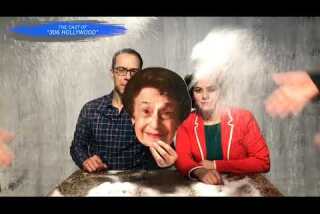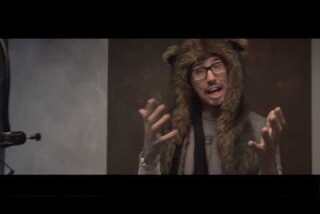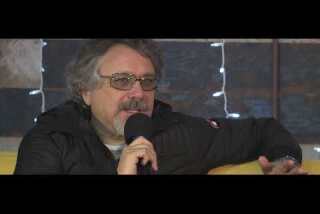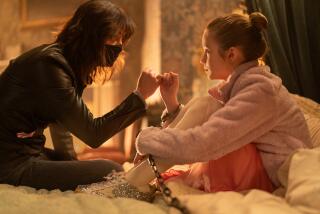On apocalypse and companionship with the creative team of ‘I Think We’re Alone Now’

A person alone may not be lonely. As “I Think We’re Alone Now” opens, a solitary man goes about his regular routines in a post-apocalyptic world that seems empty of all other people.
He methodically sweeps through neighborhoods looking for supplies — batteries are an essential — while also dutifully disposing of any dead bodies he comes across. He is unexpectedly content with this new life. A young woman suddenly appears and he finds himself less alone, and challenged over what he really needs.
The movie premiered as part of the U.S. dramatic competition at this year’s Sundance Film Festival. Just a few hours before its first public screening, director Reed Morano, stars Peter Dinklage and Elle Fanning and screenwriter Mike Makowsky sat around a suitably Sundance rustic chic dining table at a small house in Park City to talk about the movie.
The project began when Makowsky’s script, written on spec, made its way to Dinklage, who came on as a producer as well as an actor. They approached Morano about directing, impressed by her debut feature “Meadowland,” a moody tale starring Olivia Wilde.
FULL COVERAGE: Sundance Film Festival 2018 »
Morano was already an acclaimed cinematographer — with credits including Sundance premieres “The Skeleton Twins” and “Kill Your Darlings,” as well as the HBO series “Looking” and some segments of Beyoncé’s “Lemonade” — before turning to directing, and did double duty as director of photography for “I Think We’re Alone Now” too. She recently enjoyed a major career boost, winning an Emmy for her work directing the “The Handmaid’s Tale” premiere episode, and is currently making the espionage thriller “The Rhythm Section” starring Blake Lively.
With Morano locked in, the creative team could fully explore the sadness and strangeness of Makowsky’s story, in which Dinklage’s character of Del, never much of a people person to begin with, appears perfectly comfortable with being the apparent last living human on earth. That is until the arrival of Fanning’s Grace, who makes him realize what he has been missing.
“The idea that you’d have an apocalypse movie, and the incredibly beautiful twist that this guy is OK with it. It’s really funny,” said Dinklage. “And with that, really uncomplicated to put the pieces together. It’s just me and her, and you’ve just got to get the right director and have her deal with all the problems of it. It’s such a small movie. Then we realized it wasn’t after a while.”
“It’s deceiving on the page,” said Morano. “And then you’re like, ‘Oh wait, we have to make it the apocalypse.’”
For Fanning, the film’s unconventional storytelling struck her right away.
“It was kind of presented to me that this was an apocalypse film, so my mind before reading it automatically went to a place of a certain tone,” Fanning said. “Once I started the script, and realizing that’s not what it was, it was such a pleasant surprise. The apocalypse, they never explain it.”

The film has an internal tension between how spare the imagery is, mostly just one or two people in a scene, at times with little dialogue, and the richness of the ideas and emotions that it grapples with. Morano credits much of the movie’s off-kilter feelings to its intricate sound design, which incorporates the sounds of whales, caves and other sources. And, she said, the movie has a lot on its mind.
“I like movies as a viewer that challenge me to actually think rather than spoon feed everything to me,” said Morano. “And when I read Mike’s script I thought, here’s an opportunity for that. It’s actually about these people relating to each other and a lot of the things that have to do with human relationships and just humanity.
“And I think if you can make something that gives you almost everything in a weird way — its emotional, it’s scary, it’s tense, it’s funny, and it’s surreal and impressionistic — it felt like it had the opportunity to be all those things, so it would be fun.”
Knowing that she wanted a certain look for the movie, Morano searched online for possible locations and came across a public library in Hastings-on-Hudson, N.Y., that would become one of the film’s main settings.
“I wanted big windows because I knew I was going to be doing a lot of lighting from outside and I knew I wanted to light nothing from inside,” Morano said. “I was finally going to light a movie the way I wanted to.”
The production also used other towns throughout the Hudson River Valley in New York. Needing streets blocked off entirely and having no house lights or anything distracting in the background proved to be quite a challenge.
“We couldn’t really impose on one town for the whole movie,” said Morano. “Basically people wanted to kill us after we’d been there for like two or three days.”
“We asked a lot of them,” said Dinklage. “‘Can you please not walk down your street?’”
Makowsky noted the way in which Morano’s dual role as cinematographer affected the feeling on set and the performances.
“The level of intimacy and empathy she derives from just physically being behind the camera, she’s not 500 feet away in video village, she is there,” he said. “That kind of storytelling, that kind of lens really engenders a kind of empathy that is extraordinary, that you don’t normally see.”
Makowsky added that from their earliest meetings, when Morano arrived with an elaborate look book of images and a playlist of music, “She saw the movie clearly already.”
As the relationship between Del and Grace develops, the movie walks a fine line as to whether their feelings veer toward the romantic. Even among themselves, the creative team behind the movie seem to each have their own ideas of what the relationship grows into.
“It’s about companionship, really, and whatever that means to you,” Morano said. “It could be anything — it could be a brother, a best friend, a lover, a parental figure. I think in the apocalypse when there’s no one else around, the other person has to be everything to you. And that’s a weird concept.”
“There’s no ‘The One’ because there’s only one person around,” said Fanning.
“It’s not a romance but it’s definitely a love story,” she said. “These people change each other.”
SIGN UP for the free Indie Focus movies newsletter »
2018 Sundance Film Festival


Video: Adapting 'Hamlet' for a woman's point of view in 'Ophelia'

Video: 2018 Sundance Film Festival Boomerangs

Video: A behind-the-scenes look at the 2018 Sundance L.A. Times photo/video studio

Video: The Kronos Quartet premieres its live documentary

"The Kindergarten Teacher" shows something many movies don't

Video: Filmmakers share thoughts on the future of women in film, the U.S. and storytelling
Follow on Twitter: @IndieFocus
More to Read
Only good movies
Get the Indie Focus newsletter, Mark Olsen's weekly guide to the world of cinema.
You may occasionally receive promotional content from the Los Angeles Times.







